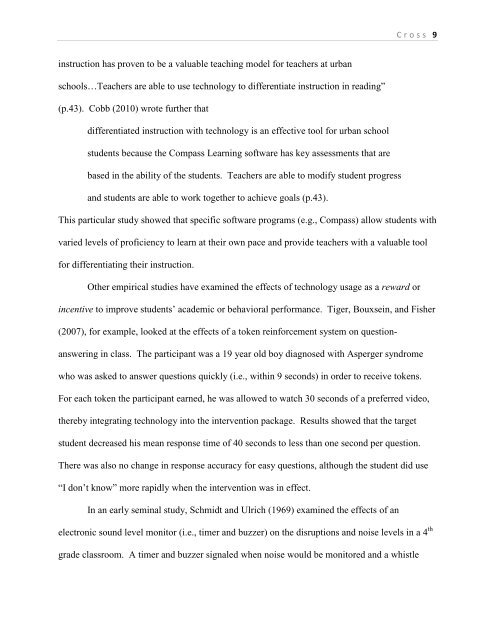THE EFFECTS OF A TIMER AND MYSTERY MOTIVATORS ON THE ...
THE EFFECTS OF A TIMER AND MYSTERY MOTIVATORS ON THE ...
THE EFFECTS OF A TIMER AND MYSTERY MOTIVATORS ON THE ...
Create successful ePaper yourself
Turn your PDF publications into a flip-book with our unique Google optimized e-Paper software.
C r o s s 9<br />
instruction has proven to be a valuable teaching model for teachers at urban<br />
schools…Teachers are able to use technology to differentiate instruction in reading”<br />
(p.43). Cobb (2010) wrote further that<br />
differentiated instruction with technology is an effective tool for urban school<br />
students because the Compass Learning software has key assessments that are<br />
based in the ability of the students. Teachers are able to modify student progress<br />
and students are able to work together to achieve goals (p.43).<br />
This particular study showed that specific software programs (e.g., Compass) allow students with<br />
varied levels of proficiency to learn at their own pace and provide teachers with a valuable tool<br />
for differentiating their instruction.<br />
Other empirical studies have examined the effects of technology usage as a reward or<br />
incentive to improve students’ academic or behavioral performance. Tiger, Bouxsein, and Fisher<br />
(2007), for example, looked at the effects of a token reinforcement system on questionanswering<br />
in class. The participant was a 19 year old boy diagnosed with Asperger syndrome<br />
who was asked to answer questions quickly (i.e., within 9 seconds) in order to receive tokens.<br />
For each token the participant earned, he was allowed to watch 30 seconds of a preferred video,<br />
thereby integrating technology into the intervention package. Results showed that the target<br />
student decreased his mean response time of 40 seconds to less than one second per question.<br />
There was also no change in response accuracy for easy questions, although the student did use<br />
“I don’t know” more rapidly when the intervention was in effect.<br />
In an early seminal study, Schmidt and Ulrich (1969) examined the effects of an<br />
electronic sound level monitor (i.e., timer and buzzer) on the disruptions and noise levels in a 4 th<br />
grade classroom. A timer and buzzer signaled when noise would be monitored and a whistle
















